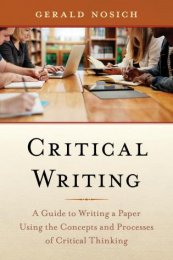Additional Information About:
Critical Writing: A Guide to Writing a Paper Using the Concepts and Processes of Critical Thinking
With Critical Writing, Gerald Nosich has filled a gaping hole in the current pedagogical literature about helping students think more critically and then use that thinking to write effectively across disciplines. Many books about this topic provide a prescriptive formula for critical thinking, but most texts do not offer students a way to adapt their thinking processes to their own purposes and individuality. That Nosich provides guidance to both instructors and students with plenty of examples and exercises combined with added emphasis on the crucial role self-reflection plays in all writing sets this text above others in the field.
— Ann M. Pearson, San Jacinto College
Though good thinking and good writing are intimately connected, textbooks often neglect this important link, focusing either on writing techniques or on critical thinking theories and strategies. Nosich’s text fills a gap in the market by offering students and teachers a practical guide for embedding critical thinking into the writing process. Drawing on both his deep knowledge of critical thinking and his decades of experience as a classroom instructor, Nosich offers readers a robust and substantive discussion of critical writing, the act of applying critical thinking concepts, traits, and strategies to research and writing. This text would be a valuable addition to any class focused on cultivating skills in writing, critical thinking, or research methods.
— Amanda Hiner, coordinator, Critical Reading, Thinking, and Writing Program, Winthrop University
Nosich’s approach to using the Paul-Elder framework for Critical Thinking is practical and user-friendly, employing a clear and comprehensive set of tools for strong writing based on sound critical thinking. This well-designed and highly readable guidebook is an outstanding resource for anyone who wants to write well, in any non-fiction genre.
— Kathleen Gibson-Dee, founding director, The Critical & Creative Thinking Conference
I highly recommend this book to all faculty who want their students to learn how to write papers of quality focused on issues of importance. This book stands above traditional approaches to writing in that it emphasizes the importance of reasoning in understanding and exploring issues at the heart of a written paper, and it details the explicit tools of critical thinking relevant to high quality writing. The critical thinking approach so clearly and expertly detailed by Dr. Nosich in this book—in readily accessible language—should be required in all writing courses.
— Linda Elder, president & senior fellow, The Foundation for Critical Thinking
This volume appeals to faculty, students, and others, who appreciate a structured and accessible approach to improving their writing. I especially like Dr. Nosich's unpretentious, conversational tone that keeps readers engaged, and provides practical solutions to the writing challenges they face.
— Eileen Z. Taylor, North Carolina State University
As an English professor who has endeavored to teach composition permeated with systematic, critical thinking for many years, this newest book by Gerald Nosich, Critical Writing: A Guide to Writing a Paper Using the Concepts and Processes of Critical Thinking, has once again supplied me with powerful and practical strategies for teaching. I first met Dr. Nosich at a seminar by The Foundation of Critical Thinking where I was at once captivated by his amazing teaching presentation and sound ideas for the classroom, especially in the area of writing critically with original content. Every time I attend these conferences, I seek out Dr. Nosich’s presentations and never fail to be inspired; I always return to my students with more effectiveness in helping them to produce higher-level academic writing. I am preparing my next Composition 1 course with this new book in hand.
— Patti Parsons, Palm Beach State College
